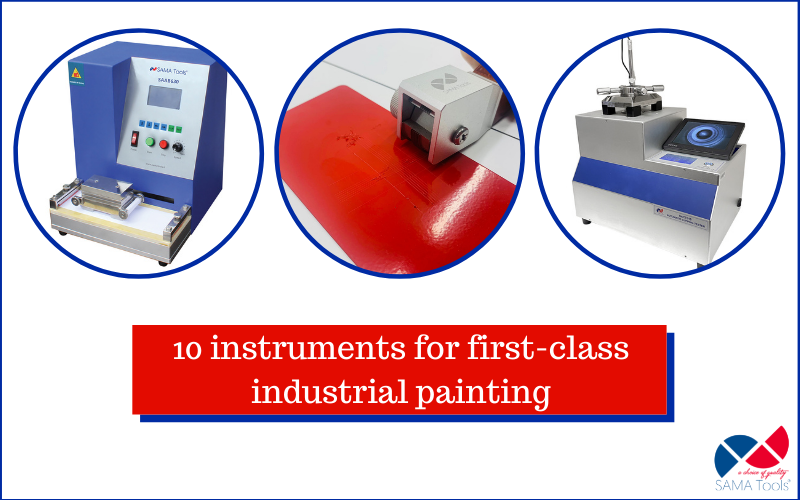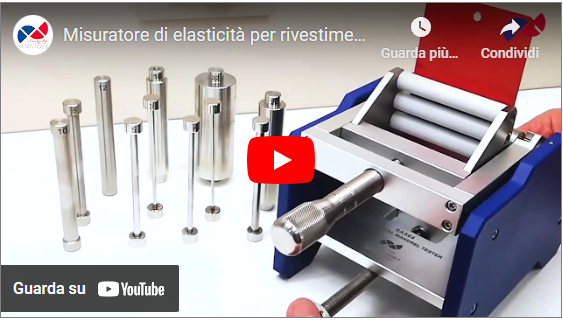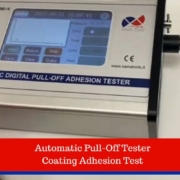10 instruments for first-class industrial coating
Industrial painting is a process that requires great attention to detail and in-depth knowledge of measuring instruments to ensure the quality of the finished product.
In this article, we’ll explore the 10 best measuring tools for your industrial paint plant.
When it comes to coating, many think that paint is used solely to enhance objects aesthetically. While it’s true that coatings can have a decorative purpose, in the industrial field, it represents much more than an aesthetic improvement.
Industrial varnishing is normally used to apply a protective coating to the surface of the product. There are three main advantages that can be obtained from this type of protective coating:
It prevents corrosion and thus increases the shelf life.
It provides fireproof protection.
It reduces energy consumption by using reflective paints to keep buildings cool, reducing the use of air conditioning.
Choosing the right measuring tools is essential to ensure the accuracy and quality of the painting process.
Let us now look at the 10 tools for first-class industrial coating.
1. Cross hatch testers
Cross hatch testers are instruments used to measure and verify the adhesion of the coating layers to the support and the adhesion between layers when several layers of coating are applied.
This is essential for industrial paint plants and third-party laboratories to guarantee the quality and longevity of the protective coating. The better the paint adheres to the support, the better protection it can provide and the longer it will protect the asset.
The cross hatch tester is very simple to use, see for yourself in the video below!
With these instruments, the process is very straight forward. The head of the tester is position orthogonally on the tested sample and then moved in a sliding motion to track a grid on the coating.
The resulting status of the coating is then compared to an international table to determine the grade of adhesion.
2. Pull-off adhesion tester
As we mentioned before, adhesion is a very important aspect for the quality and longevity of industrial painting.
Therefore, to take your industrial painting to the next level you need to test and ensure the adhesion is adequate. And the pull-off adhesion tester helps you do exactly that.
This instrument takes its name from the fact that it measures the force needed to pull the coating off the surface of the tested sample. This is done with a diameter specified by the test and by means of hydraulic pressure.
By evaluating pull-off strength of a coating, it is possible to determine the greatest tensile pull-off force that it can bear before detaching. It is also possible to identify breaking points, which are seen by fractured surfaces. This usually occur along the weakest plane within the system consisting of dolly, adhesive, coating layers and substrate.
SAMA Tools supplies you with a digital pull-off adhesion tester with the following features:
- Simple and portable with a built-in rechargeable lithium battery.
- High accuracy for optimized results.
- Increased versatility for a higher efficiency.
- Sturdy and resistant.
3. Coating bend testers
Another important aspect for achieving a first-class industrial painting is determining the crack resistance and the stripping performance of the coating. And this can be done with a coating bend tester.
These instruments are very simple to use, and they do not require special skills to perform the test. The coating bend test is normally based on a “pass/fail” or “diameter to failure” result, which means you only need to bend the sample around the cylindrical shaft or conical mandrel of the tester and see what happens to the coating on the sample.
Simple, practical, and very useful to determine coating properties such as elasticity, adhesion and elongation of coatings on sheet metal subject to bending.
At this point in the list, you might also be interested in this article: Film mechanical performance measurement.
4. Cupping testers
This is another instrument to control the quality of the protective coating in the industrial painting industry.
With a cupping tester it is easy to evaluate the resistance to cracks and detachment of the coating layers applied on metal substrate.
The test basically consists of three steps:
- Clamping the sample into a wheel.
- Cupping the sample by a hemispherical indenter onto a die.
- Verifying the result to determine the depth of failure.
We offer two different models of cupping testers. The SACT 309 which is manual and comes with an illuminated magnifying glass for easier verification of the result and a digital display to see the value of the depth of failure, and the SACT 310 which is automatic. It eliminates the risk of human error and is equipped with a digital camera for increased accuracy.

In photo: Digital cupping testers SACT309 – SACT310
5. Impact testers
Another important aspect for industrial painting is the resistance of the coating to impact. Impact testers can be used to perform a wide variety of impact tests where the main goal is to measure the amount of energy absorbed during a shock that may cause a fracture.
For the industrial painting sector, these testers provide versatility, since they can test different types of coatings, including:
- Paints
- Varnishes
- Water-based wood coatings
- High-viscosity plastic coatings
- Laminated coatings
The verification methods for the results of these tests include the pass/fail method and the grading method.
For the first method, a standard-weighted hammer falls from a determined height and is used to see if the test result complies with the standard or not, while for the second one, the height or the mass of the hammer are increased gradually to measure the minimum mass and/or height for which the coating layer cracks or breaks from the substrate.
6. Hardness testers
When formulating coatings, industrial painting manufacturers and third-party laboratories need to consider how to balance the properties of the coating for the specific application. An excess of hardness may come with increased in brittleness or a decrease of flexibility, which may not be good for the coating requirements.
Therefore, testing the hardness of the coating is also essential to guarantee high-quality industrial painting. And this can be done based on different standards, which is why there are different instruments.
The most common hardness testers are:
• Pencil hardness testers
• Buchholz coatings hardness testers
• Pendulum hardness testers

In photo: hardness testers by SAMA Tools
We also talked about hardness testers in an article about a LinkedIn survey. Click here to read it!
7. Scratch testers
Although they can be considered a type of hardness tester, scratch testers are actually used to measure critical loads related to the adhesion of the coating.
The procedure involves generating a controlled scratch with an indenter on a selected area. This is achieved by following these 3 steps:
- A stylus is placed in contact with the surface
- The stylus is moved with a linearly increasing load until failure occurs.
- The load where the failure occurs is measured and recorded as the critical load.
According to test procedures, the load applied can be constant or progressive in order to get different levels of failure.
8. Solvent rub resistance tester (MEK test)
As it was mentioned before, industrial painting is usually applied to protect pieces which are exposed to harsh environments. Gererally, the coatings applied will suffer wear in the long run ,due to such exposure.
Here’s where the solvent rub resistance tester becomes important. The test consists of scratching the surface with a gauze soaked with methylethylketone (MEK) until failure of the film occurs.
The type of gauze, the stroke distance, the stroke rate, and approximate applied scratch pressure depend on the standard used for the test.
The scratches are counted as double (one rub forward and one rub backward constitutes a double rub).
The result of the test is a quick relative estimation of the wear degree without having to wait for long-term exposure results.
9. Rub resistance tester
Although the name sounds similar to the previous instrument, the rub resistance tester is used to measure the abrasion resistance of printed materials.
Common materials tested include, but are not limited to:
- Labels
- Folding cartons
- Corrugated boards
- Packaging materials with graphics on a flat substrate
It is important to highlight that the rubbing in this test is done by means of rubber pads due to the nature of the materials tested.

In photo: Rub resistance tester – SAAB630
10. Rotational abrasion tester
Another important item in this list of 10 instruments for first-class industrial painting is the rotational abrasion tester.
This instrument allows the verification of another essential property of the coating, abrasion resistance. Some coatings are applied on special components which are in contact with other moving components or exposed to abrasion from the wind and other elements, hence the importance of testing this property.
With the rotational abrasion tester, the resistance of the coating is tested using rotary rubbing.
Here are the steps of the process
- The sample is places on the tester rotary plate.
- The sample is subjected to the action of two abrasive wheels with a determined pressure. The abrasive action is obtained by rotation of the sample along the vertical axis, while two abrasive wheels rotate above it.
- The two wheels cover a complete rotation on the surface of sample, and they allow to verify abrasion resistance at every possible angle icompared to the sample.
- The abrasion degree is measured and recorded, depending on the load applied which is usually 500g, 750g or 1000g.
- The resulting abrasion is measured by the difference in weight of the sample before and after the test.
Before we get to the final conclusions we think you might also be interested in the case study of C&L Verniciatura, using the surface sandblasting roughness tester
and Salt spray test to check corrosion resistance.
Final thoughts
It is now clear how important correct industrial painting and varnishing can affect the duration and resistance of the coating. Improper applications can lead to problems such as corrosion, delamination and premature wear of the coating. Quality control of coatings is therefore essential to ensure that finished products meet customer expectations.
The quality control of coatings involves a series of tests and controls to evaluate the quality of the finished product. These tests may include adhesion tests, hardness tests, corrosion resistance tests and wear resistance tests. The evaluation of the results allows to identify any defects and to take the necessary corrective measures.
We are sure that using a combination of tools from the list will help you exponentially improve your industrial painting business.
Of course, in addition to the tools shared here, we offer a wide variety of NDT instruments for various purposes.
Our mission is to assist customers in their quality control activities, always providing the best solutions to ensure satisfaction. Whether you work in the paint industry or in another quality control department, your success is our primary concern and we’d be happy to have you as a client!
If you need help with one of the tools on the list or would like advice on the best tool for your specific case, our technical department is happy to assist you. You can contact us at 0584/392342 – 0584/392453 or send an email to sales@samatools.it. Don’t hesitate to contact us, we’re here to help!
Don’t have time to read the whole article?
We have prepared an equally comprehensive video in English where you will find everything you need to know about the 10 instruments for first-class industrial painting!














